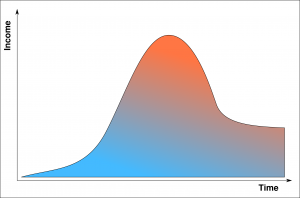One way some people are making big money is by building a viable business, such as a Niche Website, and then selling it. The following should help you understand what to look for before selling or buying a Niche Website. Once you’ve done it 2 or 3 times, you’ll have a good feel for it and know exactly what to do. If you’ve been in business for only a little bit and are not sure how to proceed, this post helps you understand the various points to look at when contemplating a Niche Website transfer.
Note that when you are a beginner, you may want to first create your own website. You may have the money to purchase an existing website, but know that you may run into various problems that you would avoid, were you to create a new Niche Website from scratch. That being said, having a website with existing traffic and good content is not a bad decision to make. Creating your own website, though, may be helpful to you as a valuable learning experience.
An Example: HoTMaiL
The HoTMaiL service was first created in 1996 by Sabeer Bhatia and Jack Smith. The two lived in Silicon Valley (Mountain View) and had the idea of creating a free mail system that would be financed by advertising.
Their endeavor worked very well and was sold to Microsoft the following year, in 1997, for an estimated $400 million. Since then, the name of the service changed several times: MSN Hotmail, live.com and outlook.com (More info about Hotmail can be found on Wikipedia.)
Calculating the Worth of Your Niche Website
Although you are not likely to be able to sell a Niche Website for 400 million dollars, it is definitely possible to create a service worth half a million. This is doable because your website, at some point, is going to generate money. The price of such a website varies depending on the niche you picked. You should look closely at what others say they could fetch before accepting an offer. A minimum is to get the total amount your Niche Website can produce within a year and multiply that number by two. For example:
| Month | Income |
|---|---|
| Jan | $25,000 |
| Feb | $20,000 |
| Mar | $18,000 |
| Apr | $15,000 |
| May | $17,000 |
| Jun | $16,000 |
| Jul | $18,000 |
| Aug | $14,000 |
| Sep | $20,000 |
| Oct | $21,000 |
| Nov | $23,000 |
| Dec | $26,000 |
| Total: | $233,000 |
Here we see the income of a Niche Website which goes between $14k and $25k a month. The total for the year comes to $233k (note that this total does not include expenses.) The value of this website is going to be about:
$233k × 2 = $466k.
What Affects the Price of a Niche Website?
There are of course many parameters that can affect the worth of a business, be it a Niche Website or otherwise. There are a few points I think are important.
Expenses
In general, the total amount of expenses in a year is not taken in account when you calculate the worth of a Niche Website business. This is because in most cases that amount is rather small.
I think that, in most cases, an evergreen Niche Website needs little if any maintenance:
- A few pages of fresh content
- Maintenance of the CMS (WordPress upgrades itself, but not its plugins!)
- Review of comments
- Accept offers for guest posts (you need to at least read and possibly edit each one of them!)
Out of these, really only upgrading the CMS is what’s the most important to make sure that the website doesn’t get hacked and your whole endeavor destroyed.
On the other hand, there are various types of website that require constant attention and upgrade:
- news website
- contemporary political website
- list of coupons and other special offers
- gizmo reviews
In other words, any website which is not exclusively built of evergreen content. Note that some websites have a lot of evergreen content explaining basics. For example, a photography website would probably have both: evergreen and constantly upgraded content:
- Evergreen
- Physics about Lens
- How to Adjust Focus
- Lights, importance, setup…
- Etc.
- Up to Date Content
- New camera XYZ review
- Lens L1 compared to Lens P5
- Etc.
With such a setup, you get strong content with the evergreen pages because Google indexes those and sends you a pretty constant stream of readers. This helps you get traffic and a certain number of these visitors are going to be interested in your review of Camera XYZ and click the link to Amazon and purchase that camera giving you a few bucks as the affiliate.
Now the Up to Date Content is a “constant struggle” as new content has to be added all the time. This is because Camera XYZ is going to grow old within 6 months and after that period of time, you need to talk about Camera ABC instead. Now, it’s not going to be much of a struggle if you love what you’re talking about on your website and testing those new cameras, lenses, etc. That being said, it needs to happen, constantly. This costs you some time that you have to reserve to make sure that your Niche Website evolves as expected. For that reason, you may end up hiring people who can help you write new articles, edit existing articles to improve them, update some pages to add Internal Links or fix information that could have changed over time (i.e. the price of an item, although remember that for Amazon Affiliates, including a price is not authorized by Amazon.com.)
So, in our example above, we find that the website has a $233k gross income. If out of that grand total you have $200k of expenses (for example you have a full staff, but you do not withdraw a salary for yourself, and the payroll costs you around $200k a year,) then you are not likely to be able to sell that business for $466k. Instead, it would be closer to $233k – $200k = $33k times two, so around $66k would be viable.
What Factor Should I Use?
In my example above, I used a factor of 2. You calculate how much income you make in one year and multiply that amount by 2.
This factor very much depends on a few parameters as described in the following table:
| Parameter | Increase | Decrease |
|---|---|---|
| Content | Evergreen Maintenance costs stay very low. | Fresh Content required Constant maintenance means possibly hiring people and maintaining that staff. |
| Competition | Very Competitive Prices are strong and large amount of goods are being sold. This is very positive. | Little Competition Others can easily enter the market and steal a consequent amount of your market share. |
| Market Share | Large In a field with a large market (i.e. many possible customers), you can make more sales; the field is likely more competitive too. | Small Your promise of large numbers of sales decreases as the market shrinks since fewer people are likely to buy from you. |
The factor is a rather important part of your Niche Website pricing so please spend the necessary time to review all aspect of your business before settling for a price. You could leave a lot of money on the table otherwise.
Ranking of the Website (Verifying Validity)
In the old days, you could ask Google what the PageRank of various pages of a website was. These days are long gone (Google stopped offering that information in 2013.) With that rank, it was possible to get an idea of the authority or influence that website had.
Truth be told since the rank could quickly change in either direction, the information was not really as useful as it seemed and, in some cases, a black hat could create an artificial rank of 6 or 7 out of 10 making the website look like it was very valuable. Only that rank would plummet a few months later…
Now, I would strongly advise that you check the website and get a feel for it. Your very own feel is going to be a lot better than whatever robots are going to tell you about that website. That being said, you could ask to get access to various tools to see the current status of the website:
- Google Search Console
- Check the Search Traffic » Links to Your Site. If that list is still empty, then the value of the website is probably rather low.
- Check the Search Traffic » Mobile Usability. Chances are many of your visitors are going to be using a mobile device to search for whatever you’re talking about on your Niche Website. If this has many issues you won’t know how to fix, you may want to withdraw from that deal altogether (at least until all of those problems get fixed by the existing owner.)
- Check the Crawl » Crawl Errors. If there are errors, make sure they will be easy to fix.
- Check the Search Traffic » Search Analytics. The traffic should show good numbers as you were told by the seller. Check both: Clicks and Impressions.
- Google Analytics
- Check that there are many hits as expected.
- Check that hits are distributed among several pages; no need for them to be on all pages, just a few primary pages that attract readers for one reason or another will do.
- Google Search Mobile Friendliness — go to this website and verify that Google thinks the website is valid for Mobile devices
- Google PageSpeed Insights — go to this website and verify that Google likes that website. Note that you could fix the website, but a broken website is not likely to receive much traffic in its current state.
When is the Right Time to Sell?
When creating a new business that has a product or service that can be sold to many people, the business income is likely to look like this bell curve.
I read Crossing the Chasm about this phenomenon. Although it does not happen 100% of the time, or you can create multiple bells one after another, this is still what happens most of the time:
At first, you have very few people who are interested and the income is much less than the expense. Then comes a steep increase when many new adopters come in. Once most have gotten what they wanted, late adopters purchase those items, often because they can’t purchase the old version they were so used to and loved. Finally, the curve stabilized at a point when people just replace their product as required over time.
The best time to sell such a business is when the curve is going up fast. This is before the curve starts slowing down (so not once it reached the top or started to go back down…) The amount of time it takes to go from one point to another very much depends on the type of business. Some businesses take off within weeks, others take years. When the bell curve happens, though, it is usually very fast. One or two years in the Technological Industry.
My first answer would be: whenever you’re ready.
First of all, you may want to keep at least one of your Niche Websites so you continue to have a constant recurring income. The only reason for selling your main cash cow is if you are looking into retiring. I would actually suggest you keep 4 or 5 if you have that many. This is because one could stop working and if that’s the only one you keep, you’d be in trouble in terms of income.
In some cases, you create a website and you never really get any traction. This is difficult to sell for any large amount of money since you’re not going to have much of an income to show for on that one. Still, it could be gold for someone else, so putting that website for sale is always a good way of getting someone to look into it and make a few bucks for your existing work.
If you are looking into creating Niche Websites with the aim to sell them, you want to look into selling once they have a decent amount of traffic and start generating money. How much you want to sell them for is what you should look into before taking the decision. However, a good Niche Website is likely to have an apogee after just a very few years (3 or 4) so I think that one of the best time to sell it is when it is still going up which would be between 1 and 2 years in. Remember that you’re not going to have consequent traffic for about 6 months (unless you are lucky and becomes that happy target of an Internet Influencer and get a stream of visitors in the thousands for a while, kick-starting your traffic.) Therefore there is usually no point in trying to sell a Niche Website before it reaches about 1 year of age.
Proceeding with the Transfer
Once you and your peer decided on a price, you can move forward with the website and domain name transfer (the domain name is optional if you plan to change it anyway.)
I strongly suggest that you look into using the services of a third party neutral broker such as Escrow to process your transaction unless you know that the other party is trustworthy or you do the transfer together at a meeting in person.
Make sure that you get everything transferred to you:
- Website database
- Website content, extensions (themes, plugins, etc.) — the whole WordPress folder
- Domain name, unless you want a new one and do not need the old one (however, if you do not get the old domain name transferred to yourself, you are likely to lose very good traffic and SEO juice)
- Analytics Accounts — remember to verify the website with your own codes once the account was transferred; the code from the previous owner won’t be compatible
- Google Analytics
- Google Search Console
- Bing Analytics
- Etc.
- Social Media Accounts
- Etc.
- Email Addresses; once you get the domain, you probably will get that along; however, in most cases the smaller frames
Note that the seller may instead give you access to his existing account instead of transferring the website. In that case, make sure to remove the seller once you were able to access the account. This generally means removing his user from the account. Now I don’t know whether this is possible at very many host companies. If the seller just gives you their credentials, then make sure to replace the email and password to yours. If you want to share a password during the transaction, make sure that this shared password is not used anywhere else and gets replaced before the end of the transaction. If you take over an existing account, make sure that all the data in the account is yours. This means all the email addresses, passwords, your street address, your real name, etc. everything has to be changed to you once you get a hold of the account. In all cases, you want to talk with the host company to make sure it is okay with them to switch users of an account and once the switch is started that you indeed change everything required to lock the seller out for good.
Note that Bluehost allows account transfers in that manner (where the new user is given access and the old user access is released) but only if you first contact them. At the moment, this contact has to be done by email to their legal department. Each hosting company has its own policy, so expect great variations on this theme.
The next step is to go through the website, page by page, and replace all the affiliate links with your own links. If no affiliate links were present yet, you should look into adding some. Don’t stress out too much. Spend the necessary time to make sure you use the correct links is more important than sending people to the wrong page. So work on one page, then test all the links to make sure you’re on the right track.


